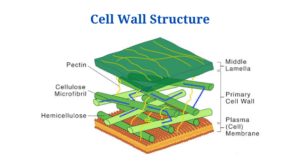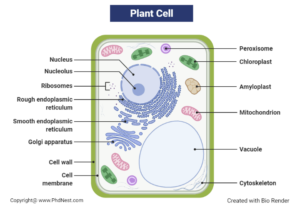Cell Wall Definition
- Around the inner plasma membrane, an outermost layer provides protection and strength to the cell. This outermost layer is the cell wall.
- Protoplast, a living structure, forms the non-living cell wall.
- The cell wall is not a characteristic of all types of cells. Some cells show their presence like plant cells, fungi, algae, and bacteria and are absent in some like animal cells.
- If we look at the composition of the plant cell wall, it is made up of some polysaccharides like cellulose, hemicelluloses, pectin, and protein. While in the fungus cell wall, chitin is the main element. Similarly, bacterial cell walls contain peptidoglycan in them. On the whole, the composition of cell walls varies in different types of cells.
Cell Wall Structure
The cell wall is a rigid structure. This rigidity is due to the covering of a polysaccharide layer that helps in maintaining the cell shape and gives protection.
How to increase Brain Power – Secrets of Brain Unlocked
The Plant Cell Wall
- The unique feature of the plant cell wall is that it is multi-layered and is further divided into three main parts or layers named as the middle lamella, primary cell wall, and the secondary cell wall.
- Middle lamella and the primary cell wall are present in all plant cells, but you will not see secondary cell walls in all plant cells.
- Middle lamella:
This is the outer layer composed of pectin, which is a polysaccharide and thus helps bind cells to one another.
- Primary cell wall:
In between the middle lamella and plasma membrane, the primary cell wall is present. This cell layer is mostly found in young growing plant cells and is composed of polysaccharides like cellulose, hemicelluloses, and pectin. The primary cell wall helps the younger plant cells in their growth by providing flexibility and support.
- Secondary cell wall:
Secondary cell wall is present between the primary cell wall and plasma membrane. The secondary cell wall is formed by thickening the primary cell wall, which has stopped growing further. This rigid layer is much thicker and contains lignin and some other chemicals. These chemicals provide extra strength to the secondary cell wall.
Click Here for Complete Biology Notes
Fungal Cell Wall
The fungal cell wall is composed of three main components:
- Chitin
Chitin is the main component of the fungal cell wall. Chitin is synthesized in the plasma membrane and is mainly consists of unbranched chains of β-(1,4)-linked-N-Acetylglucosamine or poly-β-(1,4)-linked-N-Acetylglucosamine (chitosan).
- Glucans
Glucose polymers cross-link chitin or chitosan polymers. The glucose molecules like β-glucan are linked via β-(1,3)- or β-(1,6)- bonds while α-glucans are linked by α-(1,3)- or α-(1,4) bonds and protects the cell wall.
- Proteins
In addition to structural proteins like glycosylated, the enzymes vital for the synthesis and breakdown of the cell wall are also present. Glycosylated contain mannose, and such proteins are also called mannoproteins or mannans.
Bacterial Cell Wall
The main component that forms the bacterial cell wall is peptidoglycan, also known as murein. Peptidoglycan contains polysaccharide chains that are cross-linked with peptides containing D-amino acids.
- The unique structure of the bacterial cell wall is due to the composition of disaccharide-pentapeptide subunits.
- N-acetylglucosamine and N-acetylmuramic acid are the disaccharides that are linked to N-acetylmuramic acid molecules.
- Polymer subunits like these cross-link to each other via peptide bridges to form peptidoglycan sheets, and these peptidoglycan sheets are present around the whole cell.
- Bacterial cell wall is further divided into two categories, the gram-positive and gram-negative bacteria. The main difference between these two layers is the thickness level of the peptidoglycan layer. Gram-positive bacteria have a thicker peptidoglycan layer than gram-negative ones.
- Moreover, gram-positive bacteria contain teichoic acids or ribitol phosphate polymers. On the other hand, gram-negative bacterial cell walls contain lipoteichoic acid.
Cell Wall Functions
- Support:
The main function of the cell wall is to give strength and support. It acts as a mechanical barrier against harmful environmental elements.
- Withstand turgor pressure:
The cell wall provides rigidity and helps in maintaining the cell direction and shape. Withstanding turgor pressure help the inner cell contents to push inside the plasma membrane and thus keep the cell erect.
- Regulate growth:
The cell wall acts as regulatory machinery in controlling the cell growth and maintaining the cell division and growth cycle.
- Regulate diffusion:
Many pores in the cell wall allow vital substances like lipids and proteins to enter into the cell and block the other unwanted substances from the cell.
- Communication:
Plasmodesmata is the main communication channel between the outer cell wall and the inner cell content. It connects and allows signals to pass in between the plant cell.
- Protection:
The cell wall acts as a physical boundary and protects the cell against harmful viruses or other pathogens. It also helps in desiccation and water loss.
- Storage:
The essential chemicals like carbohydrates and enzymes are stored in the cell wall and are used for cell growth when needed.
Cell Wall Citations
- Alberts, B. (2004). Essential cell biology. New York, NY: Garland Science Pub.
- Verma, P. S., & Agrawal, V. K. (2006). Cell Biology, Genetics, Molecular Biology, Evolution & Ecology (1 ed.). S .Chand and company Ltd.
- Tille, P. M., & Forbes, B. A. (2014). Bailey & Scott’s diagnostic microbiology (Thirteenth edition.). St. Louis, Missouri: Elsevier.
- Madigan, Michael T.; Martinko, John M.; Brock, Thomas D. (2005). Brock biology of microorganisms (11th ed.). Upper Saddle River, NJ: Pearson Prentice Hall.
Related Posts
- Phylum Porifera: Classification, Characteristics, Examples
- Dissecting Microscope (Stereo Microscope) Definition, Principle, Uses, Parts
- Epithelial Tissue Vs Connective Tissue: Definition, 16+ Differences, Examples
- 29+ Differences Between Arteries and Veins
- 31+ Differences Between DNA and RNA (DNA vs RNA)
- Eukaryotic Cells: Definition, Parts, Structure, Examples
- Centrifugal Force: Definition, Principle, Formula, Examples
- Asexual Vs Sexual Reproduction: Overview, 18+ Differences, Examples
- Glandular Epithelium: Location, Structure, Functions, Examples
- 25+ Differences between Invertebrates and Vertebrates
- Lineweaver–Burk Plot
- Cilia and Flagella: Definition, Structure, Functions and Diagram
- P-value: Definition, Formula, Table and Calculation
- Nucleosome Model of Chromosome
- Northern Blot: Overview, Principle, Procedure and Results


















